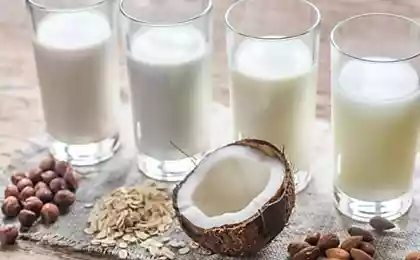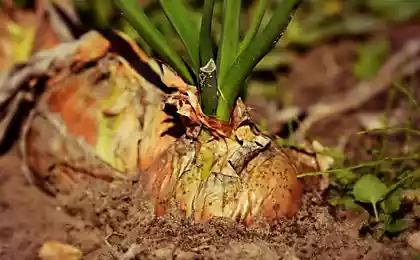134
Dairy fertilizer to increase the yield of cucumbers and tomatoes
Feeding with whey is an effective technique that experienced gardeners actively use on their plots. This allows you to increase yield and protect plants from fungal diseases.

Most often, whey is used on cucumbers and tomatoes, but it will be useful for almost all vegetables and even fruit trees. About how this fertilizer works and how it should be applied, we will tell in our article.
Serum rich in microelements, minerals, lactose, proteins, carbohydrates and vitamins, whey is a byproduct in the production of cheese and cottage cheese.

This natural fertilizer brings invaluable benefits to plants. The zinc, iron, calcium, potassium, phosphorus and amino acids that make up it help plants actively build up green mass and give quality fruits.

In addition, when spraying, the sour-milk solution covers the leaves with a thin film, which is an impassable barrier for fungi. And insect pests die from the fact that they cannot digest the lactose contained in the serum.
What plants are used for whey? Most often, whey is used to feed cucumbers and tomatoes. Good perceive sour-milk fertilizer zucchini, patissons, onions, radishes, turnips, carrots, beets.

From fruit trees, whey is useful to apple trees, from garden flowers - roses and peonies. The serum solution is effective against pathogens of phytophthorosis and powdery dew.
If you need to carry out root processing, dilute serum in water at room temperature in a proportion of 1 to 10. Field this solution root system within a radius of 50 cm from the stems of plants.

Extraroot feeding is better carried out with a solution of water and serum in a proportion of 3 to 1. For better adherence, add a few spoons of liquid soap.

Only a freshly prepared product should be used. If milk fungi begin to ferment, unwanted pathogenic microflora may appear, harmful to plants.
When it is better to process cucumbers, you should start feeding with a serum solution after the first leaves appear. Alternate root and extraroot processing. The interval between them should be 1-2 weeks.

Tomatoes, like cucumbers, are processed 7 days after transplantation. And then once a week throughout the growing season. The last feeding is carried out a few days before the start of harvest.
Interesting fact: 100 grams of milk contains 125 mg of milk, and cottage cheese, which is made from milk, only 70 mg. Where does the rest of the calcium go? In the production of curds, it goes into serum.
Whey is a very undervalued product. It is in acid whey that up to 20% of proteins remain, almost all B vitamins and 60-80% of minerals from milk. So here everyone should choose: drink whey or feed this useful product cucumber beds.

Most often, whey is used on cucumbers and tomatoes, but it will be useful for almost all vegetables and even fruit trees. About how this fertilizer works and how it should be applied, we will tell in our article.
Serum rich in microelements, minerals, lactose, proteins, carbohydrates and vitamins, whey is a byproduct in the production of cheese and cottage cheese.

This natural fertilizer brings invaluable benefits to plants. The zinc, iron, calcium, potassium, phosphorus and amino acids that make up it help plants actively build up green mass and give quality fruits.

In addition, when spraying, the sour-milk solution covers the leaves with a thin film, which is an impassable barrier for fungi. And insect pests die from the fact that they cannot digest the lactose contained in the serum.
What plants are used for whey? Most often, whey is used to feed cucumbers and tomatoes. Good perceive sour-milk fertilizer zucchini, patissons, onions, radishes, turnips, carrots, beets.

From fruit trees, whey is useful to apple trees, from garden flowers - roses and peonies. The serum solution is effective against pathogens of phytophthorosis and powdery dew.
If you need to carry out root processing, dilute serum in water at room temperature in a proportion of 1 to 10. Field this solution root system within a radius of 50 cm from the stems of plants.

Extraroot feeding is better carried out with a solution of water and serum in a proportion of 3 to 1. For better adherence, add a few spoons of liquid soap.

Only a freshly prepared product should be used. If milk fungi begin to ferment, unwanted pathogenic microflora may appear, harmful to plants.
When it is better to process cucumbers, you should start feeding with a serum solution after the first leaves appear. Alternate root and extraroot processing. The interval between them should be 1-2 weeks.

Tomatoes, like cucumbers, are processed 7 days after transplantation. And then once a week throughout the growing season. The last feeding is carried out a few days before the start of harvest.
Interesting fact: 100 grams of milk contains 125 mg of milk, and cottage cheese, which is made from milk, only 70 mg. Where does the rest of the calcium go? In the production of curds, it goes into serum.
Whey is a very undervalued product. It is in acid whey that up to 20% of proteins remain, almost all B vitamins and 60-80% of minerals from milk. So here everyone should choose: drink whey or feed this useful product cucumber beds.
The qualities of a woman for whom men will cling
Typical mistake when frying a patty and why not do so






















